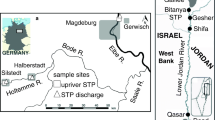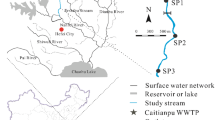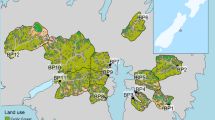Abstract
Environmental properties of organic matter contained halogen and sulfur were studied in sediments of bleached kraft pulp mill effluent (BKME) recipient lakes and 2 m3 outdoor enclosures (mesocosms). The BKME contributed to 1% (v/v) of the total water flow in the lake downstream of the pulp mill where the sediments contained 1.7 to 4 mg of tetrahydrofuran extractable organic halogen (EOX-Cl) and 0.6 to 0.8 mg of tetrahydrofuran extractable organic sulfur (EOS-S) g−1 of organic matter. Upstream sediment contained 0.03 mg of EOXCl and 0.7 mg of EOS-S g−1 of organic matter. EOX was a better indicator for the influence of BKME in the recipient sediment than EOS. The polarity of BKME contained EOX corresponded to log Kow of < 1, and that of the downstream sediment contained EOX to > 4.5. HP-SEC analysis of the molecular weight distribution (MWD) of the EOX showed a peak between 300 to 600 g mol−1 for the BKME and between 1000 to 2000 g mol−1 for the downstream sediment. The MWD of the BKME contained EOS peaked at 300 to 1000 g mol−1, and that of the downstream sediment contained EOS at 1000 to 5000 g mol−1. These results indicate that BKME contained organic halogen and sulfur undergo major structural transformations when incorporated into sediment. The biota-to-sediment accumulation factor (BSAF) of EOX from sediments formed downstream of the mill and in the mesocosms to the lipids ofLumbriculus variegatus was 0.4 to 0.7. This is of a similar order of magnitude to the BSAF reported for 2,3,7,8-tetrachlorodibenzop-dioxin and 2,3,7,8-tetrachlorodibenzofuran.
Similar content being viewed by others
Abbreviations
- ADMt:
-
Air-Dry Metric Ton
- AOX:
-
Adsorbable Organic Halogen
- AU:
-
Absorbance Unit
- BKME:
-
Bleached Kraft Pulp Mill Effluent (wastewater)
- BSAF:
-
Biota-Sediment Accumulation Factor (ratio of lipid normalized worm concentration at the end of the exposure to carbon normalized sediment concentration prior to the exposure)
- d.w:
-
Dry Weight
- EOX:
-
Extractable Organic Halogen
- HPLC:
-
High Performance Liquid Chromatography
- HPSEC:
-
High Performance Size Exclusion Chromatography
- K:
-
Octanol-water partition coefficient
- OM:
-
Organic Matter
- THF:
-
Tetrahydrofuran
- TCDD:
-
2,3,7,8-tetrachlorodibenzo-p-dioxin
- TCDF:
-
2,3,7,8-tetrachlorodibenzofuran
References
A. Karessuo (Ed.): Environmental Report. Finnish Forest Industries Federation 1996, Helsinki, Finland
E.K. Saski;K. Salonen;A. Vähätalo;M. Salkinoja-Salonen: Degradation of the halogenated organic fraction of biologically treated bleached kraft pulp mill effluents in Finnish lake water mesocosms. In: The Contaminants in the Nordic Ecosystem: Dynamics, Processes & Fate.Munawar, M.;Luotola, M. (Eds.), SPB Academic Publishing, Amsterdam. (1995) 109–123
J. Paasivirta;J. Knuutinen;P. Maatela;R. Paukku;J. Soikkeli;J. Särkkä: Organic chlorine compounds in lake sediments and the role of the chlorobleaching effluents. Chemosphere17 (1988) 137–146
P. Maatela;J. Paasivirta;J. Särkkä;R. Paukku: Organic chlorine compounds in lake sediments. II Organically bound chlorine. Chemosphere21 (1990) 1343–1354
H.T. Kankaanpää;M.A. Laurén;R.J. Saares;L.V. Heitto; Ü.K. Suursaar: Distribution of halogenated organic material in sediments from anthropogenic and natural sources in the Gulf of Finland catchment area. Environ. Sci. Technol.31 (1997) 96–104
J. Särkkä;J. Paasivirta;E. Häsänen;J. Koistinen;P. Manninen;K. Mäntykoski;T. Rantio;L. Welling: Organic chlorine compounds in lake sediments. VI. Two bottom sites of Lake Lagoda near pulp mills. Chemosphere26 (1993) 2147–2160
P. Nilsson;L. Brydsten;M. Enell;M. Jansson: Turnover of chloroorganic substances in a Bothnian Sea recipient receiving bleached kraft pulp mill effluents. In: Environmental Fate and Effects of Pulp and Paper Mill Effluents.Servos, M. R.;Munkittrick, K. R.;Carey, J. H.; van der Kraak, G. J. (Eds.), St. Lucie Press, Delray Beach, FL (1996) 203–218
H. Palm;R. Lammi: Fate of pulp mill organochlorines in the Gulf of Bothnia sediments. Environ. Sci. Technol.29 (1995) 1722–1727
F. Archibald;L. Roy-Arcand;M. Méthot: Time, sunlight, and the fate of biotreated kraft mill organochlorines (AOX) in nature. Wat. Res.31 (1997) 85–94
K.R. Millar;J.H. Carey;B.K. Burmison;H. Lee;J.T. Trevors: Degradation of the high molecular weight fraction of bleached kraft mill effluent by biological and photochemical processes. In: Environmental Fate and Effects of Pulp and Paper Mill Effluents.Servos, M. R.;Munkittrick, K. R.;Carey, J. H.; van der Kraak, G. J. (Eds.), St. Lucie Press, Delray Beach, FL. (1996) 239–251
J. Pellinen: Sorption of high molecular weight chlorolignin on sediment. Chemosphere28 (1994) 1773–1789
E.K. Saski;J.K Jokela;M.S. Salkinoja-Salonen: Biodegradability of different size classes of bleached kraft pulp mill effluent organic halogens during wastewater treatment and in lake environments. In: Environmental Fate and Effects of Pulp and Paper Mill Effluents.Servos, M. R.;Munkittrick, K. R.;Carey, J. H.; van der Kraak, G. J. (Eds.), St. Lucie Press, Delray Beach, FL (1996) 179–193
E.K. Saski;A. Vähätalo;K. Salonen;M.S. Salkinoja-Salonen: Mesocosm simulation on sediment formation induced by biologically treated bleached kraft pulp mill wastewater in freshwater recipients. In: Environmental Fate and Effects of Pulp and Paper Mill Effluents.Servos, M. R.;Munkittrick, K. R.;Carey, J. H.; van der Kraak, G. J. (Eds.), St. Lucie Press, Delray Beach, FL (1996) 261–270
J.K. Jokela;M. Laine;M. Ek;M. Salkinoja-Salonen: Effect of biological treatment on halogenated organics in bleached kraft pulp mill effluents studied by molecular weight distribution analysis. Environ. Sci. Technol.27 (1993) 547–557
J.K. Jokela;M. Salkinoja-Salonen: Molecular weight distributions of organic halogens in bleached kraft pulp mill effluents. Environ. Sci. Technol.26 (1992) 1190–1197
P.H. Kansanen;T. Jaakkola;S. Kulmala;R. Suutarinen: Sedimentation and distribution of gamma emitting radionuclides in bottom sediments of Southern Lake Päijänne, Finland after the Chernobyl accident. Hydrobiologia222 (1991) 121–140
K. Martinsen;A. Kringstad;G. Carlberg: Methods for determination of sum parameters and characterization of organochlorine compounds in spent bleach liquors from pulp mills and water,sediment and biological samples from receiving waters. Water Sci. Technol.20 (1988) 13–24
American Society for Testing and Materials, ASTM E 1147-92. Partition coefficient (N-octanol/water) estimation by liquid chromatography. Philadelphia (1992)
International Organization for Standardization, ISO 9562. Determination of adsorbable organic halogens (AOX), Genève (1989)
K.P. Suominen;T. Jaakkola;E. Elomaa;R. Hakulinen;M.S. Salkinoja-Salonen: Sediment accumulation of organic halogens in pristine forest lakes. Environ. Sci. Pollut. Res.4(1) (1997) 21–30
United States Environmental Protection Agency, U.S. EPA, Method 353.2. Nitrogen, nitrate-nitrite (colorimetric, automated, cadmium reduction). Cincinnati, Ohio (1978)
International Organization for Standardization/ Draft International Standard, ISO/DIS 11905-1. Water quality — Determination of nitrogen. Part 1: Method using oxidative digestion with peroxodisulfate. Genève (1995)
A.E. Greenberg;L.S. Clesceri;A.D. Eaton (Eds): 4500-P E. Phosphorus. Ascorbic acid method. Standard Methods for the Examination of Water and Wastewater 18th Ed., APHA, AWWA, WEF. Washington, DC. (1992)
A.E. Greenberg;L.S. Clesceri;A.D. Eaton (Eds): 4500-P B. Phosphorus. 5. Persulfate digestion method. Standard Methods for the Examination of Water and Wastewater 18th Ed., APHA, AWWA, WEF, Washington, DC. (1992)
International Organization for Standardization, ISO 10304-2. Water quality — Determination of dissolved anions by liquid chromatography of ions. Genève, 1995.
A.E. Greenberg;L.S. Clesceri;A.D. Eaton (Eds): 5210. Biochemical oxygen demand (BOD). Standard Methods for the Examination of Water and Wastewater 18th Ed., APHA, AWWA, WEE Washington, DC. (1992)
A.E. Greenberg;L.S. Clesceri;A.D. Eaton (Eds): 5220 C. Chemical oxygen demand. Closed reflux, titrimetric method. Standard Methods for the Examination of Water and Wastewater 18th Ed., APHA, AWWA, WEF. Washington, DC. (1992)
O.-P. Penttinen;J. Kukkonen;J. Pellinen: Preliminary study to compare body residues and sublethal energetic responses in benthic invertebrates exposed to sediment-bound 2,4,5-trichlorophenol. Environ. Toxicol. Chem.15 (1996) 160–166
J. Pellinen; J. Kukkonen; A. Herb; P. Mäkelä; A. Oikari: Bioaccumulation of pulp mill effluent-related compounds in aquatic animals. Sci. Tot. Environ. Suppl. (1993) 499–510
C. Hansch;A. Leo;D. Hoekman: Exploring QSAR. Hydrophobic, Electronic, and Steric Constants. ACS Professional Reference Book. American Chemical Society, Washington, DC. (1995)
C.C. Walden;DJ. McLeay;A.B. McKague: Cellulose production processes. In: The Handbook of Environmental Chemistry. Vol. 3, Part D. Anthropogenic compounds.Hutzinger, O. (Ed.). Springer-Verlag, New York (1986) 1–34
S. Sinkkonen;E. Kolehmainen;J. Paasivirta;J. Koistinen;M. Lahtiferä;R. Lammi: Identification and level estimation of chlorinated neutral aromatic sulfur compounds and their alkylated derivatives in pulp mill effluents and sediments. Chemosphere28(12) (1994) 2049–2066
R.H. Voss: Chlorinated neutral organics in biologically treated bleached kraft mill effluents. Environ. Sci. Technol.17 (1983) 530–537
I.Ya. Rod’ko;B.F. Scott;J.H. Carey: Analysis of pulp mill black liquor for organosulfur compounds using GC/Atomic Emission detection. In: Environmental Fate and Effects of Pulp and Paper Mill Effluents.Servos, M. R.;Munkittrick, K. R.;Carey, J. H.; van der Kraak, G. J. (Eds.), St. Lucie Press, Delray Beach, FL (1996) 195–202
J. Koistinen;T. Nevalainen;J. Tarhanen: Identification and level estimation of aromatic coeluates of polychlorinated dibenzo-p-dioxins and dibenzofurans in pulp mill products and wastes. Environ. Sci. Technol.26 (1992) 2499–2507
P. Mikkelson;J. Paasivirta;I.H. Rogers;M. Ikonomou: Studies on Eulachon tainting problem: analyses of tainting and toxic aromatic pollutants. In: Environmental Fate and Effects of Pulp and Paper Mill Effluents.Servos, M. R.;Munkittrick, K. R.;Carey, J. H.; van der Kraak, G. J. (Eds.), St. Lucie Press, Delray Beach, FL (1996) 327–333
W.M.G.M. van Loon;J.J. Boon;B. de Groot: Quantitative determination of macromolecular chlorolignosulfonic acids in water by Pyrolysis-Gas Chromatography/ Mass Spectrometry with Single Ion Monitoring. Anal. Chem.65 (1993) 1728–1735
J. Paasivirta;S. Sinkkonen;T. Rantio;D. Calamari;A. Di Guardo;M. Matthies;S. Trapp: Modelled and observed fate of selected organochlorines in the Nordic environment. In: The Contaminants in the Nordic Ecosystem: Dynamics, Processes & Fate.Munawar M. &Luotola M. (Eds.). SPB Academic Publishing, Amsterdam. (1995) 11–24
R. Diercks;S. Banerjee: Lipophilicity of a synthetic bleached kraft effluent. Environ. Sci. Technol.27 (1993) 2427–2429
M.E. Schrock;E.S. Barrowsand;L.B. Rosman: Biota-to-sediment accumulation factors for TCDD and TCDF in worms from 28-day bioaccumulation tests. Chemosphere34(5–7) (1997) 1333–1339
F. Hayer;J.C. Pihan: Accumulation of extractable organic halogens (EOX) by the freshwater mussel,Anodonta cygnaea L., exposed to chlorine bleached pulp and paper mill effluents. Chemosphere32(4) (1996) 791–803
H. Loonen;M. Tonkes;J.R. Parsons;H.A.J. Govers: Bioconcentration of polychlorinated dibenzo-p-dioxins and polychlorinated dibenzofurans in guppies after aqueous exposure to a complex PCDD/PCDF mixture: relationship with molecular structure. Aquat. Toxicol.30 (1994) 153–169
K. Martinsen;A.L. Kvernheim;G.E. Carlberg: Distribution of organohalogen in sediments outside pulp mills using sum parameters. Sci. Tot. Environ.144 (1994) 47–57
H. Kankaanpää;J. Tissari: Analysis for EOX and AOX in two industry influenced coastal areas in the gulf of Finland. Chemosphere29(2) (1994) 241–255
Author information
Authors and Affiliations
Corresponding author
Rights and permissions
About this article
Cite this article
Saski, E.K., Mikkola, R., Kukkonen, J.V.K. et al. Bleached kraft pulp mill discharged organic matter in recipient lake sediment. Environ. Sci. & Pollut. Res. 4, 194–202 (1997). https://doi.org/10.1007/BF02986344
Received:
Accepted:
Issue Date:
DOI: https://doi.org/10.1007/BF02986344




